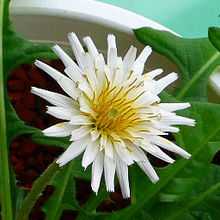Taraxacum albidum
| Taraxacum albidum | |
|---|---|
 | |
| White-flowered Japanese dandelion | |
| Scientific classification | |
| Kingdom: | Plantae |
| (unranked): | Angiosperms |
| (unranked): | Eudicots |
| (unranked): | Asterids |
| Order: | Asterales |
| Family: | Asteraceae |
| Genus: | Taraxacum |
| Species: | T. albidum |
| Binomial name | |
| Taraxacum albidum Dahlst. | |
Taraxacum albidum is a species of dandelion that grows in eastern Eurasia.[1] A member of the Asteraceae, it is a perennial herbaceous plant native to the southern part of Japan.
It is sometimes mistaken for Taraxacum coreanum, but T. coreanum grows wild chiefly in the Korean Peninsula and some parts of China. Taraxacum albidum is a cross between T. coreanum and Taraxacum japonicum. (Tatsuyoshi Morita, Moleculer phylodenetic analyese of polyoloid complex of East Asian Taraxacum [sic], 1996-1997.)[2]
Features

The deeply lobed leaves of this tap-rooted perennial plant form a basal rosette from which the long, slightly downy, unbranched hollow scapes (flower stalks) rise to around 40 cm (1 ft 4in). It blooms once a year, usually in spring (March to May)[1] but sometimes in late autumn. Each scape bears a single flower-head consisting of many small, white ray florets, opening from a rounded bud consisting of narrow green bracts.
The flowers are hermaphrodite and self-fertile.[1] It is pentaploid (having five sets of chromosomes), and produces seeds asexually like many other Taraxacum species. After pollination the flower closes, later opening as the familiar spherical seedhead or "clock", as in other dandelions. The seedhead consists of many single-seeded fruits or achenes, each attached to a pappus of fine hairs that acts as a parachute to enable wind-dispersal of the seeds, sometimes over long distances. The seeds remain dormant till autumn.
The leaves wither to avoid heat damage for several months of summer. In autumn, new leaves emerge and continue photosynthesizing until the next summer.
Uses
Although, like most dandelions, the plant is generally regarded as a weed,[3] it is occasionally grown for use as food or medicine.[1] The flowers, leaves and roots can all be used.[1]
References
- ↑ 1.0 1.1 1.2 1.3 1.4 Plants for a Future online database: Taraxacum albidum
- ↑ http://kaken.nii.ac.jp/ja/p/08640883
- ↑ T albidum01: photo description in Wikipedia Commons